Kristine Hughes's Blog, page 159
February 11, 2011
On The Shelf - Discovering New Authors - Part Three
Part Three of our series focuses on Comic Reads and, really, one can't help but opening with P.G. Wodehouse . . . . can one?
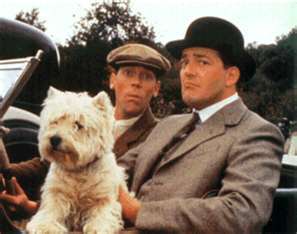 P.(Pelham) G.(Grenville) Wodehouse is best known (and loved) for his comic novels, which include the Jeeves and Wooster series and the Blandings Castle series. If you think of Stephen Fry and Hugh Laurie when you hear "Jeeves & Wooster," I'm here to tell you that the unlikely pair began life as characters in Wodehouse's books, including What Ho, Jeeves, Carry On, Jeeves and Jeeves and the Feudal Spirit, to name but a scant few. Wodehouse's books, characters and plots are just plain silly and, boy, do we love them. Prepare to stretch the limits of belief, to suspend reality and to chuckle aloud. Bertie Wooster invariably gets himself into a bind (money, girls, relatives, etc.) and Jeeves gets him out - whether Bertie ever learns about Jeeves's involvement or not. One thing Bertie is not clueless about is his dependence upon Jeeves, which this passage from Jeeves and the Hard Boiled Egg clearly illustrates:
P.(Pelham) G.(Grenville) Wodehouse is best known (and loved) for his comic novels, which include the Jeeves and Wooster series and the Blandings Castle series. If you think of Stephen Fry and Hugh Laurie when you hear "Jeeves & Wooster," I'm here to tell you that the unlikely pair began life as characters in Wodehouse's books, including What Ho, Jeeves, Carry On, Jeeves and Jeeves and the Feudal Spirit, to name but a scant few. Wodehouse's books, characters and plots are just plain silly and, boy, do we love them. Prepare to stretch the limits of belief, to suspend reality and to chuckle aloud. Bertie Wooster invariably gets himself into a bind (money, girls, relatives, etc.) and Jeeves gets him out - whether Bertie ever learns about Jeeves's involvement or not. One thing Bertie is not clueless about is his dependence upon Jeeves, which this passage from Jeeves and the Hard Boiled Egg clearly illustrates:
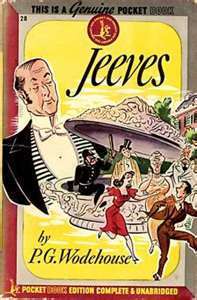 Sometimes of a morning, as I've sat in bed sucking down the early cup of tea and watched my man Jeeves flitting about the room and putting out the raiment for the day, I've wondered what the deuce I should do if the fellow ever took it into his head to leave me. It's not so bad now I'm in New York, but in London the anxiety was frightful. There used to be all sorts of attempts on the part of low blighters to sneak him away from me. Young Reggie Foljambe to my certain knowledge offered him double what I was giving him, and Alistair Bingham-Reeves, who's got a valet who had been known to press his trousers sideways, used to look at him, when he came to see me, with a kind of glittering hungry eye which disturbed me deucedly. Bally pirates!
Sometimes of a morning, as I've sat in bed sucking down the early cup of tea and watched my man Jeeves flitting about the room and putting out the raiment for the day, I've wondered what the deuce I should do if the fellow ever took it into his head to leave me. It's not so bad now I'm in New York, but in London the anxiety was frightful. There used to be all sorts of attempts on the part of low blighters to sneak him away from me. Young Reggie Foljambe to my certain knowledge offered him double what I was giving him, and Alistair Bingham-Reeves, who's got a valet who had been known to press his trousers sideways, used to look at him, when he came to see me, with a kind of glittering hungry eye which disturbed me deucedly. Bally pirates!
The thing, you see, is that Jeeves is so dashed competent. You can spot it even in the way he shoves studs into a shirt.
I rely on him absolutely in every crisis, and he never lets me down. And, what's more, he can always be counted on to extend himself on behalf of any pal of mine who happens to be to all appearances knee-deep in the bouillon. Take the rather rummy case, for instance, of dear old Bicky and his uncle, the hard-boiled egg.
Read more here and once you've finished, you can visit The World of P.G. Wodehouse here and the P.G. Wodehouse Society here. And what a backlist! For Sebastian Faulks' take on Jeeves's place in popular fiction, click here.
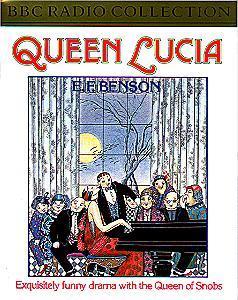 If Wodehouse is literary slapstick, E.F. Benson's humour is subtle - his characters don't realize that they've received a proverbial pie in the face until several pages on. Social one-upsmanship is rampant, and Mrs. Emmeline Lucas, known to her friends as Lucia, has artistic pretensions and exchanges Italian phrases with her consort, the perennial bachelor Georgey Pilson, alongside whom she can often be found practising the piano. Lucia's adversary is Miss Elizabeth Mapp, who once ruled as the town of Tilling's social queen until Lucia moved in and displaced her. Let the games begin. For a taste of just how far Lucia will go where pretension is concerned, here's a passage from Queen Lucia, in which Lucia returns to her new home in Tilling: "Something of the consciousness of her sovereignty was in her mind, as she turned the last hot corner of the road and came in sight of the village street that constituted her kingdom. Indeed it belonged to her, as treasure trove belongs to the Crown, for it was she who had been the first to begin the transformation of this remote Elizabethan village into the palace of culture that was now reared on the spot where ten years ago an agricultural population had led bovine and unilluminated lives in their cottages of grey stone or brick and timber. Before that, while her husband was amassing a fortune, comfortable in amount and respectable in origin, at the Bar, she had merely held up a small dim lamp of culture in Onslow Gardens. But both her ambition and his had been to bask and be busy in artistic realms of their own when the materialistic needs were provided for by sound investments, and so when there were the requisite thousands of pounds in secure securities she had easily persuaded him to buy three of these cottages that stood together in a low two-storied block. Then, by judicious removal of partition-walls, she had, with the aid of a sympathetic architect, transmuted them into a most comfortable dwelling, subsequently building on to them a new wing, that ran at right angles at the back, which was, if anything, a shade more inexorably Elizabethan than the stem onto which it was grafted, for here was situated the famous smoking-parlour, with rushes on the floor, and a dresser ranged with pewter tankards, and leaded lattice-windows of glass so antique that it was practically impossible to see out of them. It had a huge open fireplace framed in oak-beams with a seat on each side of the iron-backed hearth within the chimney, and a genuine spit hung over the middle of the fire. Here, though in the rest of the house she had for the sake of convenience allowed the installation of electric light, there was no such concession made, and sconces on the walls held dim iron lamps, so that only those of the most acute vision were able to read. Even then reading was difficult, for the book-stand on the table contained nothing but a few crabbed black-letter volumes dating from not later than the early seventeenth century, and you had to be in a frantically Elizabethan frame of mind to be at ease there. But Mrs Lucas often spent some of her rare leisure moments in the smoking-parlour, playing on the virginal that stood in the window, or kippering herself in the fumes of the wood-fire as with streaming eyes she deciphered an Elzevir Horace rather late for inclusion under the rule, but an undoubted bargain."
If Wodehouse is literary slapstick, E.F. Benson's humour is subtle - his characters don't realize that they've received a proverbial pie in the face until several pages on. Social one-upsmanship is rampant, and Mrs. Emmeline Lucas, known to her friends as Lucia, has artistic pretensions and exchanges Italian phrases with her consort, the perennial bachelor Georgey Pilson, alongside whom she can often be found practising the piano. Lucia's adversary is Miss Elizabeth Mapp, who once ruled as the town of Tilling's social queen until Lucia moved in and displaced her. Let the games begin. For a taste of just how far Lucia will go where pretension is concerned, here's a passage from Queen Lucia, in which Lucia returns to her new home in Tilling: "Something of the consciousness of her sovereignty was in her mind, as she turned the last hot corner of the road and came in sight of the village street that constituted her kingdom. Indeed it belonged to her, as treasure trove belongs to the Crown, for it was she who had been the first to begin the transformation of this remote Elizabethan village into the palace of culture that was now reared on the spot where ten years ago an agricultural population had led bovine and unilluminated lives in their cottages of grey stone or brick and timber. Before that, while her husband was amassing a fortune, comfortable in amount and respectable in origin, at the Bar, she had merely held up a small dim lamp of culture in Onslow Gardens. But both her ambition and his had been to bask and be busy in artistic realms of their own when the materialistic needs were provided for by sound investments, and so when there were the requisite thousands of pounds in secure securities she had easily persuaded him to buy three of these cottages that stood together in a low two-storied block. Then, by judicious removal of partition-walls, she had, with the aid of a sympathetic architect, transmuted them into a most comfortable dwelling, subsequently building on to them a new wing, that ran at right angles at the back, which was, if anything, a shade more inexorably Elizabethan than the stem onto which it was grafted, for here was situated the famous smoking-parlour, with rushes on the floor, and a dresser ranged with pewter tankards, and leaded lattice-windows of glass so antique that it was practically impossible to see out of them. It had a huge open fireplace framed in oak-beams with a seat on each side of the iron-backed hearth within the chimney, and a genuine spit hung over the middle of the fire. Here, though in the rest of the house she had for the sake of convenience allowed the installation of electric light, there was no such concession made, and sconces on the walls held dim iron lamps, so that only those of the most acute vision were able to read. Even then reading was difficult, for the book-stand on the table contained nothing but a few crabbed black-letter volumes dating from not later than the early seventeenth century, and you had to be in a frantically Elizabethan frame of mind to be at ease there. But Mrs Lucas often spent some of her rare leisure moments in the smoking-parlour, playing on the virginal that stood in the window, or kippering herself in the fumes of the wood-fire as with streaming eyes she deciphered an Elzevir Horace rather late for inclusion under the rule, but an undoubted bargain."
For an in-depth article on these characters and the series, read the Philip Hensher article here. You'll find the E.F. Benson Society's
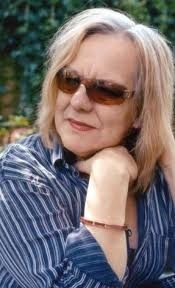
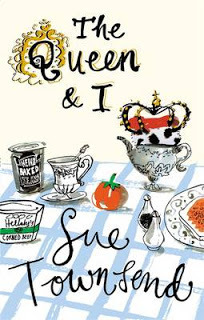 Sue Townsend set Victoria's sense of humor zinging with her hilarious book The Queen and I. Somehow, the characters of Queen Elizabeth, the Duke of Edinburgh, and the Queen Mother rang completely true when I first read it back in 1992. After they became non-royal in the fictional republic, they seemed quite natural. I completely bought the idea that Liz would turn into an excellent cook with the cheapest cuts of meat and that the Duke of E. would be very upset that Liz wanted to be known as Mrs. Windsor rather than Mrs. Mountbatten from now on.
Sue Townsend set Victoria's sense of humor zinging with her hilarious book The Queen and I. Somehow, the characters of Queen Elizabeth, the Duke of Edinburgh, and the Queen Mother rang completely true when I first read it back in 1992. After they became non-royal in the fictional republic, they seemed quite natural. I completely bought the idea that Liz would turn into an excellent cook with the cheapest cuts of meat and that the Duke of E. would be very upset that Liz wanted to be known as Mrs. Windsor rather than Mrs. Mountbatten from now on.
Sue Townsend has written a sequel called Queen Camilla, published in 2006, which I have not found, But it's now high on my list. She is well-known for her wonderful series of books about Adrian Mole.
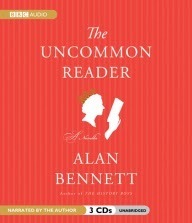
Another book featuring royalty is Alan Bennett's The Uncommon Reader, a novella by the writer of the Tony-winning play The History Boys and The Madness of King George, this story has the Queen discovering the joys of reading through a palace kitchen worker named Norman. Soon, Her Majesty's preoccupation with literature leads to fears of senility amongst royal insiders. If they thought the Queen's reading a book was bad, just wait till they learn she means to write one . . . . .
Part Four Coming Soon!
 P.(Pelham) G.(Grenville) Wodehouse is best known (and loved) for his comic novels, which include the Jeeves and Wooster series and the Blandings Castle series. If you think of Stephen Fry and Hugh Laurie when you hear "Jeeves & Wooster," I'm here to tell you that the unlikely pair began life as characters in Wodehouse's books, including What Ho, Jeeves, Carry On, Jeeves and Jeeves and the Feudal Spirit, to name but a scant few. Wodehouse's books, characters and plots are just plain silly and, boy, do we love them. Prepare to stretch the limits of belief, to suspend reality and to chuckle aloud. Bertie Wooster invariably gets himself into a bind (money, girls, relatives, etc.) and Jeeves gets him out - whether Bertie ever learns about Jeeves's involvement or not. One thing Bertie is not clueless about is his dependence upon Jeeves, which this passage from Jeeves and the Hard Boiled Egg clearly illustrates:
P.(Pelham) G.(Grenville) Wodehouse is best known (and loved) for his comic novels, which include the Jeeves and Wooster series and the Blandings Castle series. If you think of Stephen Fry and Hugh Laurie when you hear "Jeeves & Wooster," I'm here to tell you that the unlikely pair began life as characters in Wodehouse's books, including What Ho, Jeeves, Carry On, Jeeves and Jeeves and the Feudal Spirit, to name but a scant few. Wodehouse's books, characters and plots are just plain silly and, boy, do we love them. Prepare to stretch the limits of belief, to suspend reality and to chuckle aloud. Bertie Wooster invariably gets himself into a bind (money, girls, relatives, etc.) and Jeeves gets him out - whether Bertie ever learns about Jeeves's involvement or not. One thing Bertie is not clueless about is his dependence upon Jeeves, which this passage from Jeeves and the Hard Boiled Egg clearly illustrates: Sometimes of a morning, as I've sat in bed sucking down the early cup of tea and watched my man Jeeves flitting about the room and putting out the raiment for the day, I've wondered what the deuce I should do if the fellow ever took it into his head to leave me. It's not so bad now I'm in New York, but in London the anxiety was frightful. There used to be all sorts of attempts on the part of low blighters to sneak him away from me. Young Reggie Foljambe to my certain knowledge offered him double what I was giving him, and Alistair Bingham-Reeves, who's got a valet who had been known to press his trousers sideways, used to look at him, when he came to see me, with a kind of glittering hungry eye which disturbed me deucedly. Bally pirates!
Sometimes of a morning, as I've sat in bed sucking down the early cup of tea and watched my man Jeeves flitting about the room and putting out the raiment for the day, I've wondered what the deuce I should do if the fellow ever took it into his head to leave me. It's not so bad now I'm in New York, but in London the anxiety was frightful. There used to be all sorts of attempts on the part of low blighters to sneak him away from me. Young Reggie Foljambe to my certain knowledge offered him double what I was giving him, and Alistair Bingham-Reeves, who's got a valet who had been known to press his trousers sideways, used to look at him, when he came to see me, with a kind of glittering hungry eye which disturbed me deucedly. Bally pirates! The thing, you see, is that Jeeves is so dashed competent. You can spot it even in the way he shoves studs into a shirt.
I rely on him absolutely in every crisis, and he never lets me down. And, what's more, he can always be counted on to extend himself on behalf of any pal of mine who happens to be to all appearances knee-deep in the bouillon. Take the rather rummy case, for instance, of dear old Bicky and his uncle, the hard-boiled egg.
Read more here and once you've finished, you can visit The World of P.G. Wodehouse here and the P.G. Wodehouse Society here. And what a backlist! For Sebastian Faulks' take on Jeeves's place in popular fiction, click here.
 If Wodehouse is literary slapstick, E.F. Benson's humour is subtle - his characters don't realize that they've received a proverbial pie in the face until several pages on. Social one-upsmanship is rampant, and Mrs. Emmeline Lucas, known to her friends as Lucia, has artistic pretensions and exchanges Italian phrases with her consort, the perennial bachelor Georgey Pilson, alongside whom she can often be found practising the piano. Lucia's adversary is Miss Elizabeth Mapp, who once ruled as the town of Tilling's social queen until Lucia moved in and displaced her. Let the games begin. For a taste of just how far Lucia will go where pretension is concerned, here's a passage from Queen Lucia, in which Lucia returns to her new home in Tilling: "Something of the consciousness of her sovereignty was in her mind, as she turned the last hot corner of the road and came in sight of the village street that constituted her kingdom. Indeed it belonged to her, as treasure trove belongs to the Crown, for it was she who had been the first to begin the transformation of this remote Elizabethan village into the palace of culture that was now reared on the spot where ten years ago an agricultural population had led bovine and unilluminated lives in their cottages of grey stone or brick and timber. Before that, while her husband was amassing a fortune, comfortable in amount and respectable in origin, at the Bar, she had merely held up a small dim lamp of culture in Onslow Gardens. But both her ambition and his had been to bask and be busy in artistic realms of their own when the materialistic needs were provided for by sound investments, and so when there were the requisite thousands of pounds in secure securities she had easily persuaded him to buy three of these cottages that stood together in a low two-storied block. Then, by judicious removal of partition-walls, she had, with the aid of a sympathetic architect, transmuted them into a most comfortable dwelling, subsequently building on to them a new wing, that ran at right angles at the back, which was, if anything, a shade more inexorably Elizabethan than the stem onto which it was grafted, for here was situated the famous smoking-parlour, with rushes on the floor, and a dresser ranged with pewter tankards, and leaded lattice-windows of glass so antique that it was practically impossible to see out of them. It had a huge open fireplace framed in oak-beams with a seat on each side of the iron-backed hearth within the chimney, and a genuine spit hung over the middle of the fire. Here, though in the rest of the house she had for the sake of convenience allowed the installation of electric light, there was no such concession made, and sconces on the walls held dim iron lamps, so that only those of the most acute vision were able to read. Even then reading was difficult, for the book-stand on the table contained nothing but a few crabbed black-letter volumes dating from not later than the early seventeenth century, and you had to be in a frantically Elizabethan frame of mind to be at ease there. But Mrs Lucas often spent some of her rare leisure moments in the smoking-parlour, playing on the virginal that stood in the window, or kippering herself in the fumes of the wood-fire as with streaming eyes she deciphered an Elzevir Horace rather late for inclusion under the rule, but an undoubted bargain."
If Wodehouse is literary slapstick, E.F. Benson's humour is subtle - his characters don't realize that they've received a proverbial pie in the face until several pages on. Social one-upsmanship is rampant, and Mrs. Emmeline Lucas, known to her friends as Lucia, has artistic pretensions and exchanges Italian phrases with her consort, the perennial bachelor Georgey Pilson, alongside whom she can often be found practising the piano. Lucia's adversary is Miss Elizabeth Mapp, who once ruled as the town of Tilling's social queen until Lucia moved in and displaced her. Let the games begin. For a taste of just how far Lucia will go where pretension is concerned, here's a passage from Queen Lucia, in which Lucia returns to her new home in Tilling: "Something of the consciousness of her sovereignty was in her mind, as she turned the last hot corner of the road and came in sight of the village street that constituted her kingdom. Indeed it belonged to her, as treasure trove belongs to the Crown, for it was she who had been the first to begin the transformation of this remote Elizabethan village into the palace of culture that was now reared on the spot where ten years ago an agricultural population had led bovine and unilluminated lives in their cottages of grey stone or brick and timber. Before that, while her husband was amassing a fortune, comfortable in amount and respectable in origin, at the Bar, she had merely held up a small dim lamp of culture in Onslow Gardens. But both her ambition and his had been to bask and be busy in artistic realms of their own when the materialistic needs were provided for by sound investments, and so when there were the requisite thousands of pounds in secure securities she had easily persuaded him to buy three of these cottages that stood together in a low two-storied block. Then, by judicious removal of partition-walls, she had, with the aid of a sympathetic architect, transmuted them into a most comfortable dwelling, subsequently building on to them a new wing, that ran at right angles at the back, which was, if anything, a shade more inexorably Elizabethan than the stem onto which it was grafted, for here was situated the famous smoking-parlour, with rushes on the floor, and a dresser ranged with pewter tankards, and leaded lattice-windows of glass so antique that it was practically impossible to see out of them. It had a huge open fireplace framed in oak-beams with a seat on each side of the iron-backed hearth within the chimney, and a genuine spit hung over the middle of the fire. Here, though in the rest of the house she had for the sake of convenience allowed the installation of electric light, there was no such concession made, and sconces on the walls held dim iron lamps, so that only those of the most acute vision were able to read. Even then reading was difficult, for the book-stand on the table contained nothing but a few crabbed black-letter volumes dating from not later than the early seventeenth century, and you had to be in a frantically Elizabethan frame of mind to be at ease there. But Mrs Lucas often spent some of her rare leisure moments in the smoking-parlour, playing on the virginal that stood in the window, or kippering herself in the fumes of the wood-fire as with streaming eyes she deciphered an Elzevir Horace rather late for inclusion under the rule, but an undoubted bargain."For an in-depth article on these characters and the series, read the Philip Hensher article here. You'll find the E.F. Benson Society's

 Sue Townsend set Victoria's sense of humor zinging with her hilarious book The Queen and I. Somehow, the characters of Queen Elizabeth, the Duke of Edinburgh, and the Queen Mother rang completely true when I first read it back in 1992. After they became non-royal in the fictional republic, they seemed quite natural. I completely bought the idea that Liz would turn into an excellent cook with the cheapest cuts of meat and that the Duke of E. would be very upset that Liz wanted to be known as Mrs. Windsor rather than Mrs. Mountbatten from now on.
Sue Townsend set Victoria's sense of humor zinging with her hilarious book The Queen and I. Somehow, the characters of Queen Elizabeth, the Duke of Edinburgh, and the Queen Mother rang completely true when I first read it back in 1992. After they became non-royal in the fictional republic, they seemed quite natural. I completely bought the idea that Liz would turn into an excellent cook with the cheapest cuts of meat and that the Duke of E. would be very upset that Liz wanted to be known as Mrs. Windsor rather than Mrs. Mountbatten from now on.Sue Townsend has written a sequel called Queen Camilla, published in 2006, which I have not found, But it's now high on my list. She is well-known for her wonderful series of books about Adrian Mole.

Another book featuring royalty is Alan Bennett's The Uncommon Reader, a novella by the writer of the Tony-winning play The History Boys and The Madness of King George, this story has the Queen discovering the joys of reading through a palace kitchen worker named Norman. Soon, Her Majesty's preoccupation with literature leads to fears of senility amongst royal insiders. If they thought the Queen's reading a book was bad, just wait till they learn she means to write one . . . . .
Part Four Coming Soon!
Published on February 11, 2011 01:19
February 10, 2011
Please Help to Save the Cleveland Street Workhouse

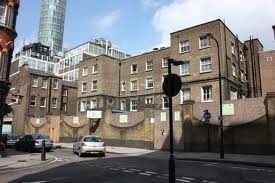
There's a petition over at the London Historians' Blog, which can also be found in our right sidebar under "Amusing Blogs." They are feverishly trying to save the Cleveland Street Workhouse, which is thought to be Dickens' inspiration for the workhouse in Oliver Twist, from demolition. Please take a moment to log onto their site and sign this document in the hopes of saving an important part of London's disappearing history. Thank you!
Published on February 10, 2011 05:44
The Wellington Connection - Attempted Assassination
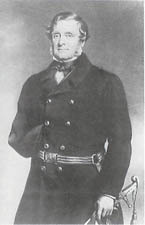 Fitzroy Somerset, later Lord Raglan From The Letters of George Canning:
Fitzroy Somerset, later Lord Raglan From The Letters of George Canning:
A letter written by Lt.-Col. Lord FitzRoy Somerset to Wellesley Pole dated Thursday, February 12, 1818.
My Dear Mr. Pole,
You have so often expressed apprehensions for the Duke's safety, that you will be more shocked, than surprised to learn, that he was shot at, the night before last, just as his carriage was entering the Porte Cochere of his house (The Duke's house was in the Rue Champs Elyses. It was from this house that the first shot was fired by Le Grange in the Revolution of 1848. It was subsequently pulled down by order of Napoleon III). Fortunately the shot missed entirely; but however one may exult at his escape on this occasion, the fact that it is intended to take away his life is so clear, that one cannot but dread that another attempt may be more effectual.
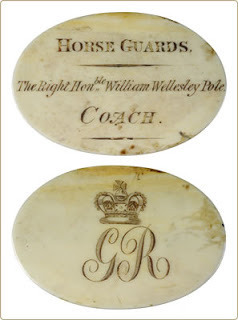 Ivory coach pass belonging to
Ivory coach pass belonging to
William Wellesley Pole, Master of the
Royal Mint 1814-1823
It appears by the evidence of the coachman and footman, that as the carriage passed by the Hotel d'Abrantes, which you may recollect is at the entrance of the Rue des Champs Elysees, they observed a man standing opposite to it, who, on the approach of the carriage moved on and kept pace with it till he reached the nearest sentry box at the Duke's door, when he stopped and as the carriage was in the act of turning into the gateway the villain fired his pistol. Upon hearing the shot, the horses rather quickened their pace, which the coachman had checked to go more easily over the gutter, and the Duke arrived without accident at the house, totally unaware that he had been fired at, till the footman opened the door and said 'J'espere, Monseigneur, que votre Excellence n'est pas blesse'.' He had conceived that one of the sentries' muskets had gone off by accident. Upon ascertaining how the fact stood, the Duke ordered the assassin to be pursued, but as no step had been taken till he gave the directions to that effect, the scoundrel of course made his retreat good. If however, the sentries had been as indeed they ought to have been outside the Porte Cochere, instead of being in it, or if the footman (a Frenchman) had had his wits about him, and upon seeing the man fire, had immediately jumped down and run after him, or had even cried out he must have been taken; for two of the Duke's English servants were at the moment coming down the street, and heard the report of the pistol, and whilst they were debating upon what was the cause of the shot at such an hour (it was after midnight) they met the man running: and as one of them had said that the shot might have been fired at the Duke's carriage they had a great mind to stop him, but hearing no alarm they thought it most prudent to let him go by without molestation.
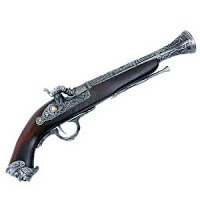 Shortly after, some of the guard detached from the Duke's came up to them and asked them if they had seen anybody, to which they replied in the affirmative, and immediately joined with the soldiers in the pursuit. One of the servants ran so fast, that he thinks he saw the same man go into a house in the Rue de la Madeleine, and stay at the door till he came up, when it was slammed in his face. This house was afterwards examined some hours after, I believe, and it appears that the only lodger is a laquais-de-place now in the service of an Englishman. The soldiers and servants continued their researches but ineffectually. The whole of yesterday was occupied by the police in the examination of everybody who could throw any light upon the affair, and in the evening a man came forth who had formerly lived as servant to Burgh, who acknowledged himself the author of an anonymous letter he had addressed Sir Ulysses about a month ago, who had communicated it to the Duke stating that he had been offered a sum of money to assassinate him. He now said that he had no personal acquaintance with the man who had made the proposition to him, but that he should know him if he were to see him, and that he was apprehensive that his own life was in danger in consequence of his refusal to undertake the murder. This laquais had been in the army and had afterwards lived with General Exelmans where he was probably remarked by the villain who wanted to induce him to perpetrate the crime. Nothing else has transpired which may tend to the discovery of the assassin, with the exception of a letter from Lord Kinnaird to Sir George Murray which you will receive through Sir Charles Stuart.
Shortly after, some of the guard detached from the Duke's came up to them and asked them if they had seen anybody, to which they replied in the affirmative, and immediately joined with the soldiers in the pursuit. One of the servants ran so fast, that he thinks he saw the same man go into a house in the Rue de la Madeleine, and stay at the door till he came up, when it was slammed in his face. This house was afterwards examined some hours after, I believe, and it appears that the only lodger is a laquais-de-place now in the service of an Englishman. The soldiers and servants continued their researches but ineffectually. The whole of yesterday was occupied by the police in the examination of everybody who could throw any light upon the affair, and in the evening a man came forth who had formerly lived as servant to Burgh, who acknowledged himself the author of an anonymous letter he had addressed Sir Ulysses about a month ago, who had communicated it to the Duke stating that he had been offered a sum of money to assassinate him. He now said that he had no personal acquaintance with the man who had made the proposition to him, but that he should know him if he were to see him, and that he was apprehensive that his own life was in danger in consequence of his refusal to undertake the murder. This laquais had been in the army and had afterwards lived with General Exelmans where he was probably remarked by the villain who wanted to induce him to perpetrate the crime. Nothing else has transpired which may tend to the discovery of the assassin, with the exception of a letter from Lord Kinnaird to Sir George Murray which you will receive through Sir Charles Stuart.
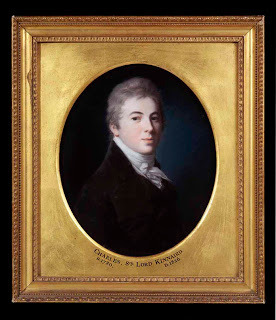 Charles, 8th Lord Kinnaird of Inchture (1780-1826)
Charles, 8th Lord Kinnaird of Inchture (1780-1826)
In this it is stated that a man had asked Lord Kinnaird if he thought the Duke of Wellington could be prevailed upon to exert his influence with M. De Cazes to grant permission for the return to Paris of three French exiles. Lord Kinnaird replied in the negative, upon which the Frenchman enquired if the Duke would be induced to facilitate their return, on condition of his disclosing a plot, which had been some time in agitation against his life. The rest of the letter contains Kinnaird's answer to this proposition and the steps which the other considers necessary, if it should be admitted. Murray by the Duke's desire has written to K. to say that before any other step is taken, he must disclose the name of his informer, and as the attempt to assassinate has since been made, Kinnaird's letter will be sent to Lord Clancarty (Ambassador to the Netherlands) who will act upon it as he thinks proper. It is impossible so immediately after the event to judge of the effect which the commission of such an outrage will make in Paris. The only people whom I have yet seen are connected with the Court and they as may naturally be supposed, express in strong terms their abhorrence of it, but the French in general are, as Lord Stanhope truly says, so unprincipled, and they carry their detestation of the Duke and of the English to such an extreme, that I do not believe many of them will really feel shocked that such an attempt should have been made, more particularly as they consider the Duke to be the author of their present degradation.
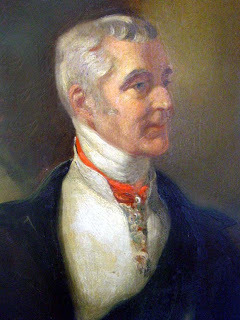 Duke of Wellington
Duke of Wellington
Much as I have been accustomed to the unostentatious courage and strength of mind so peculiar to the Duke, I acknowledge that he has on this occasion displayed a firmness and a tranquillity which has astonished me, while at the same time he has evinced a disposition to take every precaution in his power to preserve his valuable life. He is aware that if a man is determined to destroy him at the certain sacrifice of his own existence, he cannot prevent him; but he thinks, and I am inclined to entertain the same opinion, that as nobody can have any private pique against him, the person who would undertake to assassinate him, would not venture to do so except on an occasion when he might have a good chance of effecting his escape. Self predominates in the minds of every individual in this nation, and I hope that feeling may be the cause of the preservation of the Duke.
Measures are taken to guard the Duke's house and to watch the streets immediately leading to it, and he will have an Aide-de-camp always in the house, and he will have a person armed though not in uniform with his carriage. He has promised also never to go about alone and will not make use of his own carriage which is so well known.
Should I hear anything further before the messenger is dispatched I will communicate to you.
Yours most affectionately,
FitzRoy Somerset.
P.S.—Since writing the above, the Duke has shown me his letter to Lord Bathurst which is a very good one; you will observe that at the end of it he expresses a hope, that if it should be thought advisable to publish any part of his letter, care will be taken not to make known that part of it which relates to the channels which may lead to the discovery of the assassin, or to the precautions which he may think it proper to adopt. I have heard nothing further, except that an Officer of the Landers de la Garde was close to the carriage at the time, whose first impulse was to rush upon the villain, but upon second thoughts he judged it best not to attempt to seize him lest he should fail and being seen to run should be suspected of being the assassin. He therefore contented himself with enquiring if the Duke was hurt.
 Fitzroy Somerset, later Lord Raglan From The Letters of George Canning:
Fitzroy Somerset, later Lord Raglan From The Letters of George Canning:A letter written by Lt.-Col. Lord FitzRoy Somerset to Wellesley Pole dated Thursday, February 12, 1818.
My Dear Mr. Pole,
You have so often expressed apprehensions for the Duke's safety, that you will be more shocked, than surprised to learn, that he was shot at, the night before last, just as his carriage was entering the Porte Cochere of his house (The Duke's house was in the Rue Champs Elyses. It was from this house that the first shot was fired by Le Grange in the Revolution of 1848. It was subsequently pulled down by order of Napoleon III). Fortunately the shot missed entirely; but however one may exult at his escape on this occasion, the fact that it is intended to take away his life is so clear, that one cannot but dread that another attempt may be more effectual.
 Ivory coach pass belonging to
Ivory coach pass belonging to William Wellesley Pole, Master of the
Royal Mint 1814-1823
It appears by the evidence of the coachman and footman, that as the carriage passed by the Hotel d'Abrantes, which you may recollect is at the entrance of the Rue des Champs Elysees, they observed a man standing opposite to it, who, on the approach of the carriage moved on and kept pace with it till he reached the nearest sentry box at the Duke's door, when he stopped and as the carriage was in the act of turning into the gateway the villain fired his pistol. Upon hearing the shot, the horses rather quickened their pace, which the coachman had checked to go more easily over the gutter, and the Duke arrived without accident at the house, totally unaware that he had been fired at, till the footman opened the door and said 'J'espere, Monseigneur, que votre Excellence n'est pas blesse'.' He had conceived that one of the sentries' muskets had gone off by accident. Upon ascertaining how the fact stood, the Duke ordered the assassin to be pursued, but as no step had been taken till he gave the directions to that effect, the scoundrel of course made his retreat good. If however, the sentries had been as indeed they ought to have been outside the Porte Cochere, instead of being in it, or if the footman (a Frenchman) had had his wits about him, and upon seeing the man fire, had immediately jumped down and run after him, or had even cried out he must have been taken; for two of the Duke's English servants were at the moment coming down the street, and heard the report of the pistol, and whilst they were debating upon what was the cause of the shot at such an hour (it was after midnight) they met the man running: and as one of them had said that the shot might have been fired at the Duke's carriage they had a great mind to stop him, but hearing no alarm they thought it most prudent to let him go by without molestation.
 Shortly after, some of the guard detached from the Duke's came up to them and asked them if they had seen anybody, to which they replied in the affirmative, and immediately joined with the soldiers in the pursuit. One of the servants ran so fast, that he thinks he saw the same man go into a house in the Rue de la Madeleine, and stay at the door till he came up, when it was slammed in his face. This house was afterwards examined some hours after, I believe, and it appears that the only lodger is a laquais-de-place now in the service of an Englishman. The soldiers and servants continued their researches but ineffectually. The whole of yesterday was occupied by the police in the examination of everybody who could throw any light upon the affair, and in the evening a man came forth who had formerly lived as servant to Burgh, who acknowledged himself the author of an anonymous letter he had addressed Sir Ulysses about a month ago, who had communicated it to the Duke stating that he had been offered a sum of money to assassinate him. He now said that he had no personal acquaintance with the man who had made the proposition to him, but that he should know him if he were to see him, and that he was apprehensive that his own life was in danger in consequence of his refusal to undertake the murder. This laquais had been in the army and had afterwards lived with General Exelmans where he was probably remarked by the villain who wanted to induce him to perpetrate the crime. Nothing else has transpired which may tend to the discovery of the assassin, with the exception of a letter from Lord Kinnaird to Sir George Murray which you will receive through Sir Charles Stuart.
Shortly after, some of the guard detached from the Duke's came up to them and asked them if they had seen anybody, to which they replied in the affirmative, and immediately joined with the soldiers in the pursuit. One of the servants ran so fast, that he thinks he saw the same man go into a house in the Rue de la Madeleine, and stay at the door till he came up, when it was slammed in his face. This house was afterwards examined some hours after, I believe, and it appears that the only lodger is a laquais-de-place now in the service of an Englishman. The soldiers and servants continued their researches but ineffectually. The whole of yesterday was occupied by the police in the examination of everybody who could throw any light upon the affair, and in the evening a man came forth who had formerly lived as servant to Burgh, who acknowledged himself the author of an anonymous letter he had addressed Sir Ulysses about a month ago, who had communicated it to the Duke stating that he had been offered a sum of money to assassinate him. He now said that he had no personal acquaintance with the man who had made the proposition to him, but that he should know him if he were to see him, and that he was apprehensive that his own life was in danger in consequence of his refusal to undertake the murder. This laquais had been in the army and had afterwards lived with General Exelmans where he was probably remarked by the villain who wanted to induce him to perpetrate the crime. Nothing else has transpired which may tend to the discovery of the assassin, with the exception of a letter from Lord Kinnaird to Sir George Murray which you will receive through Sir Charles Stuart.
 Charles, 8th Lord Kinnaird of Inchture (1780-1826)
Charles, 8th Lord Kinnaird of Inchture (1780-1826) In this it is stated that a man had asked Lord Kinnaird if he thought the Duke of Wellington could be prevailed upon to exert his influence with M. De Cazes to grant permission for the return to Paris of three French exiles. Lord Kinnaird replied in the negative, upon which the Frenchman enquired if the Duke would be induced to facilitate their return, on condition of his disclosing a plot, which had been some time in agitation against his life. The rest of the letter contains Kinnaird's answer to this proposition and the steps which the other considers necessary, if it should be admitted. Murray by the Duke's desire has written to K. to say that before any other step is taken, he must disclose the name of his informer, and as the attempt to assassinate has since been made, Kinnaird's letter will be sent to Lord Clancarty (Ambassador to the Netherlands) who will act upon it as he thinks proper. It is impossible so immediately after the event to judge of the effect which the commission of such an outrage will make in Paris. The only people whom I have yet seen are connected with the Court and they as may naturally be supposed, express in strong terms their abhorrence of it, but the French in general are, as Lord Stanhope truly says, so unprincipled, and they carry their detestation of the Duke and of the English to such an extreme, that I do not believe many of them will really feel shocked that such an attempt should have been made, more particularly as they consider the Duke to be the author of their present degradation.
 Duke of Wellington
Duke of WellingtonMuch as I have been accustomed to the unostentatious courage and strength of mind so peculiar to the Duke, I acknowledge that he has on this occasion displayed a firmness and a tranquillity which has astonished me, while at the same time he has evinced a disposition to take every precaution in his power to preserve his valuable life. He is aware that if a man is determined to destroy him at the certain sacrifice of his own existence, he cannot prevent him; but he thinks, and I am inclined to entertain the same opinion, that as nobody can have any private pique against him, the person who would undertake to assassinate him, would not venture to do so except on an occasion when he might have a good chance of effecting his escape. Self predominates in the minds of every individual in this nation, and I hope that feeling may be the cause of the preservation of the Duke.
Measures are taken to guard the Duke's house and to watch the streets immediately leading to it, and he will have an Aide-de-camp always in the house, and he will have a person armed though not in uniform with his carriage. He has promised also never to go about alone and will not make use of his own carriage which is so well known.
Should I hear anything further before the messenger is dispatched I will communicate to you.
Yours most affectionately,
FitzRoy Somerset.
P.S.—Since writing the above, the Duke has shown me his letter to Lord Bathurst which is a very good one; you will observe that at the end of it he expresses a hope, that if it should be thought advisable to publish any part of his letter, care will be taken not to make known that part of it which relates to the channels which may lead to the discovery of the assassin, or to the precautions which he may think it proper to adopt. I have heard nothing further, except that an Officer of the Landers de la Garde was close to the carriage at the time, whose first impulse was to rush upon the villain, but upon second thoughts he judged it best not to attempt to seize him lest he should fail and being seen to run should be suspected of being the assassin. He therefore contented himself with enquiring if the Duke was hurt.
Published on February 10, 2011 01:46
February 9, 2011
Regency Reflections: Fashions of the Era
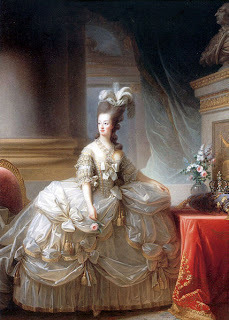
Fashions for females in the Georgian Era changed dramatically, from wide skirts and narrow waists, high-piled coiffures, and fussy decoration to simple, high waisted gowns -- and back again in the space of a few decades. Marie Antoinette (1755-1793), Queen of France, right, might have been the most extreme. She was painted in 1778 by Elisabeth Vigee le Brun (1755-1842) in a huge hooped skirt and hair powdered, drawn high and topped off with a fountain of feathers. In an upcoming post, we will look at some of the fashion plates from various lady's magazines of the Georgian era. In this post, however, we will indulge in the representations of fashion shown in portraits by celebrated artists.
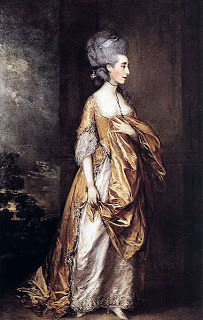
Left is Grace Dalrymple Elliott, subject of Jo Manning's excellent biography. My Lady Scandalous: The Amazing Life and Outrageous Times of Grace Dalrymple Elliott, Royal Courtesan. She was painted by Gainsborough in the late 1770's. One of the outstanding features of Gainsborough's portraits is the depiction of the sumptuous silks and satins worn by his subjects. Again, the hair-do is exaggeratedly high and powdered to a pewter shade rather than the white powdering of a few years earlier. Imagine how many hours had to be spent by these ladies while their minions teased each strand up and over whatever bird-cage-like platform was used.
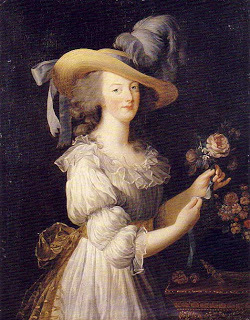
In the 1780's and 1790's, the styles became simpler, perhaps bucolic. Even the French Queen favored a version of the simple muslin chemise. The mode, color and fabric were copied by aristocrats on both sides of the Channel. Hair is more naturally arranged, though still powdered a little, and one could hardly say the hat would be worn by a peasant. Again, the painter is Vigee le Brun.
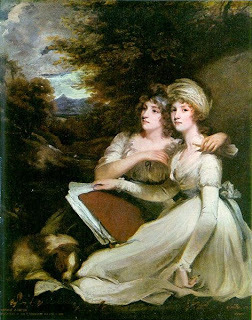 The Frankland Sisters by John Hoppner, 1795National Gallery of Art, Washington, D. C.
The Frankland Sisters by John Hoppner, 1795National Gallery of Art, Washington, D. C.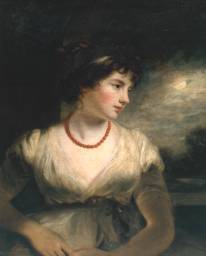 Jane Elizabeth, Countess of Oxford, 1797 by John Hoppner
Jane Elizabeth, Countess of Oxford, 1797 by John HoppnerTate BritainGradually the gowns evolved into looser skirts with high waists just below the bosom. The two portraits below by Sir Henry Raeburn(1756-1823) show the exact changes.
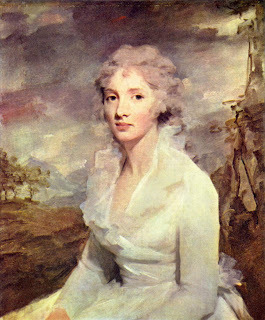 Mrs. Eleanor Urquhart, 1795
Mrs. Eleanor Urquhart, 1795National Gallery of Art, Washington, DC.
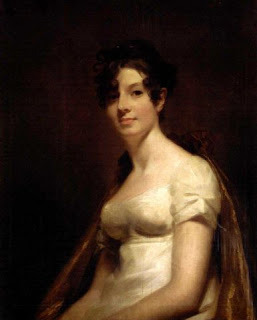 Elizabeth Campbell 1812
Elizabeth Campbell 1812 During the nine years of the Regency, fashions became more elaborate with fancy work and embellishments for the sleeves and around the hems. After about 1800, the hair powder is gone for good and the styles are simpler. By the official end of the regency in 1820, waistlines had begun to sneak back to their natural spot. In the 1820's, the corseted waist and wide skirts returned, and in the 1830's, the hair rose again. Below are two portraits by Thomas Sully (1783-1872), born in England but who lived most of his life in the United States.
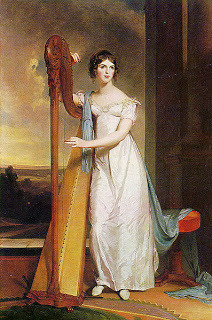
Lady with a Harp, Eliza Ridgely, 1818,
National Gallery of Art, Washington, DC
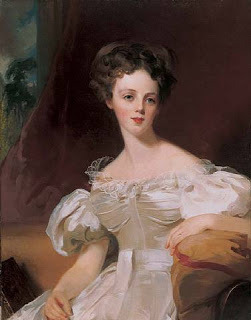 Abby Ann King Turner Van Pelt, 1832
Abby Ann King Turner Van Pelt, 1832Sir Thomas Lawrence (1769-1830) painted many portraits throughout the regency and afterwards. Here are a few of his portraits, showing the change from the late 18th century to several decades into the 19th.
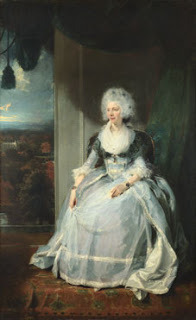 Queen Charlotte, 1789, National Gallery, London
Queen Charlotte, 1789, National Gallery, London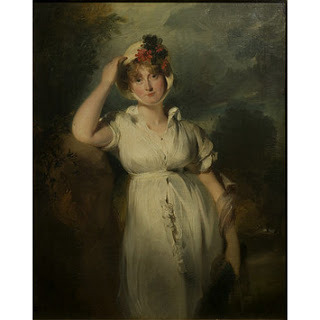 Caroline of Brunswick, Princess of Wales, 1798, Victoria and Albert Museum, London
Caroline of Brunswick, Princess of Wales, 1798, Victoria and Albert Museum, London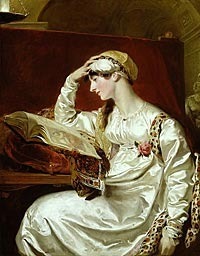 Mrs. Jens Wolff, 1815
Mrs. Jens Wolff, 1815Chicago Art Institute
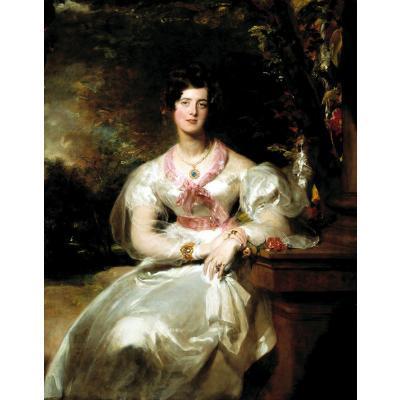 Julia Hankey, later Lady Bathurst, c. 1825
Julia Hankey, later Lady Bathurst, c. 1825Dallas Museum of Art
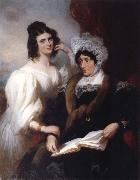 Hair has remained unpowdered throughout the late Georgian period, but by the 1830's, there were some fantastic top-knot arrangements, as seen below. Not to mention the fantastic hats that came back into style.
Hair has remained unpowdered throughout the late Georgian period, but by the 1830's, there were some fantastic top-knot arrangements, as seen below. Not to mention the fantastic hats that came back into style. To the left is a portrait of Fanny Kemble (1809-1893) with her aunt Sarah Siddons (1755-1831) painted by Henry Perronet Briggs (1791-1844) in 1831, shortly before Sarah went to her considerable reward.
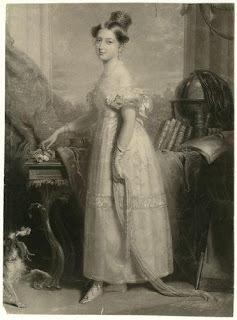 The print to the right is Princess Victoria, later Queen, based on an 1833 painting by Sir George Hayter (1792-1871). Fanny and the princess share a top-knot hair style.
The print to the right is Princess Victoria, later Queen, based on an 1833 painting by Sir George Hayter (1792-1871). Fanny and the princess share a top-knot hair style.Below is a feathered hat even Marie Antoinette would have loved. The painting hangs in the Hermitage, St. Petersburg; Sir George Hayter portrays Countess Vorontsova in 1832. Another hat the ill-fated queen might have enjoyed wearing is shown in a portrait of Julia, Lady Peel, nee Floyd (1795-1859) by Sir Thomas Lawrence; the real thing can be viewed at New York City's Frick Collection.
So the fashion cycle comes full circle in about seventy years from the 1760's to the 1830's.
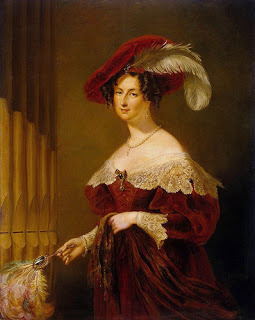
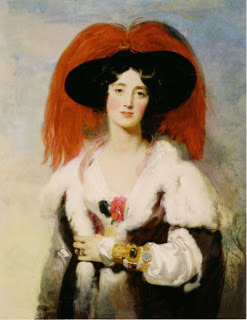
Published on February 09, 2011 02:00
February 8, 2011
Earthquake!
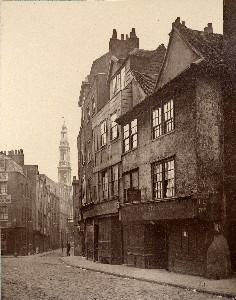 On the 8th of February, 1750, an earthquake was felt in London, followed exactly a month afterwards by a second and severer one, when the bells of the church clocks struck against the chiming-hammers, dogs howled, and fish jumped high out of the water. Horace Walpole, in a letter to Sir Horace Mann, draws a lively picture of the effect created by the event, and we cannot do better than borrow his narration:
On the 8th of February, 1750, an earthquake was felt in London, followed exactly a month afterwards by a second and severer one, when the bells of the church clocks struck against the chiming-hammers, dogs howled, and fish jumped high out of the water. Horace Walpole, in a letter to Sir Horace Mann, draws a lively picture of the effect created by the event, and we cannot do better than borrow his narration:". . . . . as far as earthquakes go towards lowering the price of wonderful commodities, to be sure we are over-stocked. We have had a second, much more violent than the first; and you must not be surprised if, by next post, you hear of a burning mountain springing up in Smithfield. In the night between Wednesday and Thursday last, the earth had a shivering fit between one and two; but so slight that, if no more had followed, I don't believe it would have been noticed. I had been awake, and had scarce dozed again,—on a sudden I felt my bolster lift my head. I thought somebody was getting from under my bed, but soon found it was a strong earthquake that lasted nearly half a minute, with a violent vibration and great roaring. I got up and found people running into the streets, but saw no mischief done. There has been some; two old houses flung down, several chimnies, and much earthenware. The bells rang in several houses. Admiral Knowles, who has lived long in Jamaica, and felt seven there, says this was more violent than any of them. The wise say, that if we have not rain soon we shall certainly have more. Several people are going out of town, for it has nowhere reached above ten miles from London: they say they are not frightened, but that it is such fine weather, "Lord, one can't help going into the country!" The only visible effect it has had was in the Ridotto, at which, being the following morning, there were but 400 people.
"A parson who came into White's the morning after earthquake the first, and heard bets laid on whether it was an earthquake or the blowing up of powder mills, went away exceedingly scandalised, and said, "I protest they are such an impious set of people, that I believe, if the last trumpet was to sound, they would bet puppet-show against judgment!" The excitement grew intense: following the example of Bishops Seeker and Sherlock, the clergy showered down sermons and exhortations, and a country quack sold pills "as good against an earthquake." (Walpole himself advised anyone who would listen to "take bark"). A crazy Life-guardsman predicted a third and more fatal earthquake at the end of four weeks after the second, and a frantic terror prevailed among all classes as the time drew near."
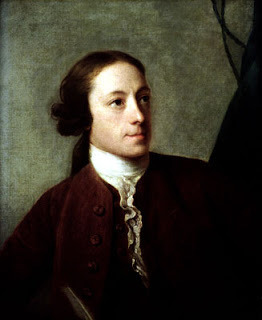 Horace WalpoleOn the evening preceding the 5th of April, the roads out of London were crowded with vehicles, spite of an advertisement in the papers threatening the publication "of an exact list of all the nobility and gentry who have left or shall leave this place through fear of another earthquake." "Earth-quake gowns "—warm gowns to wear while sitting out of doors all night—were in great request with women. Many people sat in coaches all night in Hyde Park, passing away the time with the aid of cards and candles; and Walpole asks his correspondent, 'What will you think of Lady Catherine Pelham, Lady Frances Arundel, and Lord and Lady Galway, who go this evening to an inn ten miles out of town, where they are to play brag till four o'clock in the morning, and then come back, I suppose, to look for the bones of their husbands and families under the rubbish?'
Horace WalpoleOn the evening preceding the 5th of April, the roads out of London were crowded with vehicles, spite of an advertisement in the papers threatening the publication "of an exact list of all the nobility and gentry who have left or shall leave this place through fear of another earthquake." "Earth-quake gowns "—warm gowns to wear while sitting out of doors all night—were in great request with women. Many people sat in coaches all night in Hyde Park, passing away the time with the aid of cards and candles; and Walpole asks his correspondent, 'What will you think of Lady Catherine Pelham, Lady Frances Arundel, and Lord and Lady Galway, who go this evening to an inn ten miles out of town, where they are to play brag till four o'clock in the morning, and then come back, I suppose, to look for the bones of their husbands and families under the rubbish?'On the 18th of March in the same year an earthquake was felt at Portsmouth, Southampton, and the Isle of Wight. In April, Cheshire, Flintshire, and Yorkshire were startled in like manner: this was followed by an earthquake in Dorsetshire in May, by another in Somersetshire in July, and in Lincoln-shire in August, the catalogue being completed on the 30th. of September by an earthquake ex-tending through the counties of Suffolk, Leicester, and Northampton.
N.B. The feared third London earthquake did not occur.
Published on February 08, 2011 02:12
February 7, 2011
Hand Made Tales: Women and Domestic Crafts

Drawing on the current resurgence in sewing, gardening and cooking and the historical roots of the domestic arts within the home, this exhibition at The Women's Library in London runs until April 1 and explores the ways in which household crafts have traditionally been the domain of women, their role as sources of knowledge and self-expression shared between generations and communities, and as cultural experiences nurturing the creative spirit is celebrated in the displays. Curated by Carol Tulloch, this timely exhibition will allow visitors to explore and learn the stories of crafts and the women involved in them through personal tales and fun interactive projects.
The Women's Library is a cultural centre housing the most extensive collection of women's history in the UK. We run exhibitions and events in addition to the Reading Room Service. The Women's Library has an extensive Printed collections cataloguesearch online. (books, pamphlets, periodicals and videos). Most of the Library's books, pamphlets, periodicals and videos are catalogued and available to use. The collections cover a variety of topics, such as women's rights, suffrage, sexuality, health, education, employment, reproductive rights, the family, and the home. The emphasis is primarily on women in Britain, but some international material is included.
The Library houses over 500 archives (arranged in 11 strands) that document women's lives and the issues that have concerned and interested them. They date primarily from the mid-nineteenth century to the present day and extend in size from one file to hundreds of boxes. Included are the personal papers of a wide variety of individuals, ranging from the papers of the famous suffragette Emily Wilding Davison to the papers of 2nd wave feminist Sheila Rowbotham. The records of societies and associations are also covered, including female emigration societies, women's suffrage associations, societies for the abolition of the state regulation of prostitution, societies for the suppression of traffic in persons, women's employment organisations and a myriad of other pressure groups and campaigning organisations on issues as varied as peace, single parenthood, women clergy and home economics. The records of research and oral history projects are also collected.
An online catalogue is available for searching the archives.
Published on February 07, 2011 01:58
February 6, 2011
Regency Reflections: The Regency Era Begins
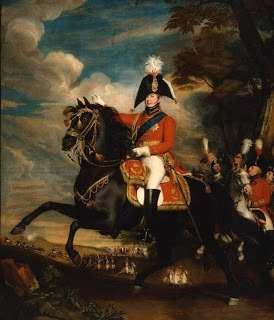 Two hundred years ago today, the English Regency began. George, Prince of Wales, swore his allegiance to King George III followed by oaths of office as Regent according to Parliamentary Acts, and as protector of the Protestant religion. The solemn ceremonies at the Prince's residence, Carlton House, were attended by the Royal Dukes, the Archbishop of Canterbury, and Parliamentary ministers led by the Prime Minister, Spencer Perceval.
Two hundred years ago today, the English Regency began. George, Prince of Wales, swore his allegiance to King George III followed by oaths of office as Regent according to Parliamentary Acts, and as protector of the Protestant religion. The solemn ceremonies at the Prince's residence, Carlton House, were attended by the Royal Dukes, the Archbishop of Canterbury, and Parliamentary ministers led by the Prime Minister, Spencer Perceval.At right, a highly flattering picture of George, Prince of Wales, by John Singleton Copley, displayed at the Royal Academy in 1810. George always yearned to be a military leader but, sadly for Copley, he did not purchase this picture. It now hangs in the Museum of Fine Arts, Boston. Its official nme is Portrait of HRH The Prince of Wales at a Review, attended by Lord Heathfield, General Turner, Col. Bloomfield, and Baron Eben; Col. Quinton in the Distance. The Prince never took the battlefield, however much he tried to convince the Duke of Wellington that he'd been at the Duke's side at Waterloo.
Up to the time of his Regency, the Prince's closest friends were associated with the Whigs, a political group of prominent aristocrats and their associates, who favored some "liberal" ideas, though one would never say they were radical reformers. The differences between the Tories and the Whigs in the early 19th century today seem rather minor. The Whigs wanted reform but just a little bit! Gradually, the Whigs came to stand for extension of the voting franchise, Catholic emancipation, abolition of slavery, and other forward-thinking policies. But, unexpectedly, the new Prince Regent did not dismiss the Tory government and appoint his old friends. Needless to say, the old buddies were not pleased.
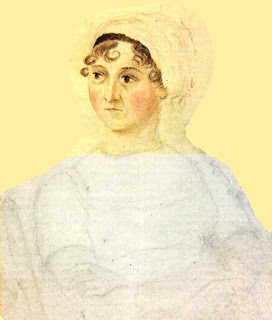 Jane Austen, NPGIs it just my bias, caused by my admiration of Jane Austen and Georgette Heyer, or were there really an unusually brilliant collection of characters in the Regency? Here are a few of the personages who capture my fancy.
Jane Austen, NPGIs it just my bias, caused by my admiration of Jane Austen and Georgette Heyer, or were there really an unusually brilliant collection of characters in the Regency? Here are a few of the personages who capture my fancy.Jane Austen (1775-1817), brilliant author. Nuff said.
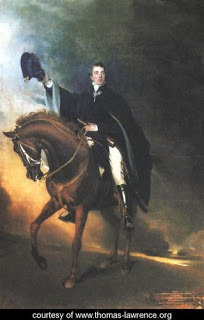 The Duke of Wellington, Waterloo victor
The Duke of Wellington, Waterloo victor 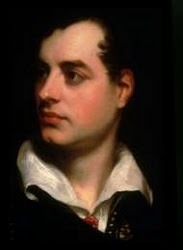 Lord Byron, mad, bad and dangerous to know
Lord Byron, mad, bad and dangerous to know
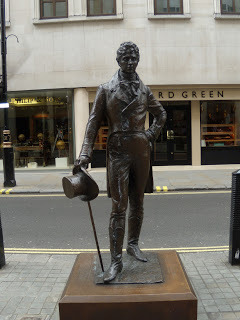 George "Beau" Brummell, fashion arbiter
George "Beau" Brummell, fashion arbiter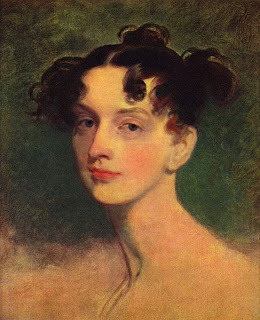 Princess Lieven, by Lawrence, c. 1813
Princess Lieven, by Lawrence, c. 1813sees all, tells all?
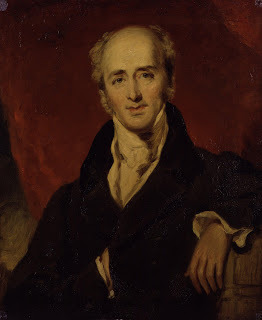 Earl Grey, led the Whig opposition
Earl Grey, led the Whig opposition 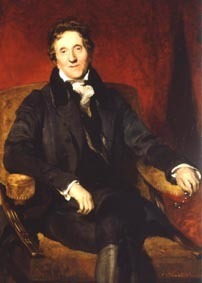 Sir John Soane, brilliant architect
Sir John Soane, brilliant architect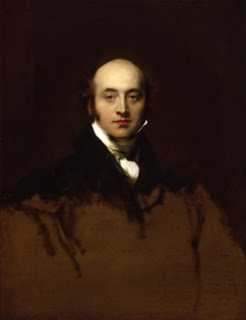 Sir Thomas Lawrence, self-portrait; he painted them all Above is just a sliver of the fascinating characters of the Regency Era. Who is your favorite? Let us know...
Sir Thomas Lawrence, self-portrait; he painted them all Above is just a sliver of the fascinating characters of the Regency Era. Who is your favorite? Let us know...
Published on February 06, 2011 02:00
February 5, 2011
Regency Reflections: On 5 February, 1811, the Regency Begins...
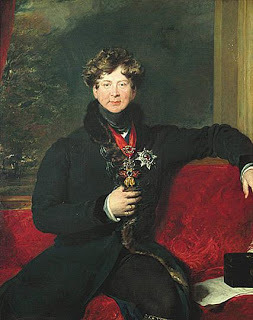
By February 5, 1811, both houses of Parliament had passed the Regency Act, making George, Prince of Wales, the Regent for his incapacitated father, George III, who was under doctors' care at Windsor Castle. The Prince took the royal oath on February 6, 1811.
He was 48 years old. He had a legal wife, Princess Caroline, whom he despised, and from whom he had been estranged since shortly after the wedding. Their daughter, Princess Charlotte of Wales, was 15 years old, and suffered from the great inconsistencies in her father's attention and attitude. She was most often ignored by him, but occasionally she was flaunted before the public, which adored her and loathed him.
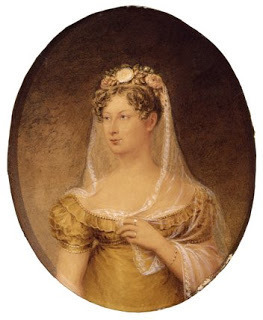 Princess Charlotte by Richard Woodman,
Princess Charlotte by Richard Woodman,
1816, NPGCharlotte was a lively girl who had limited contact with both her mother and father. She was often with her aunts, the Princesses, and her grandmother, Queen Charlotte, and only rarely with girls of her own age. From time to time, the Prince spent time with her, but he complained that her looks reminded him, painfully, of his wife. Little wonder she had the German/Hanoverian stamp, since her George and Caroline were first cousins, both grandchildren of Frederick, Prince of Wales (1707-1751), the son of George II.Princess Charlotte led a lonely life, though surrounded at all times by attendants and court-appointed companions.
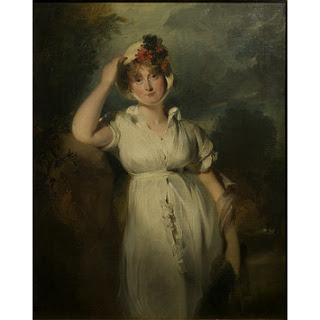 Caroline, Princess of Wales
Caroline, Princess of Wales
by Sir Thomas Lawrence, 1798, VandACaroline, by 1811, had set up a separate establishment where she entertained and socialized. Some of her behavior was reported to be scandalous, and her access to her daughter was often restricted. Caroline enjoyed -- and often flaunted -- her personal popularity with the people. She resented her position as a cast-aside wife with little or no access to court and none of the honors due her. Little wonder that there were constant rumors circulating in London society.
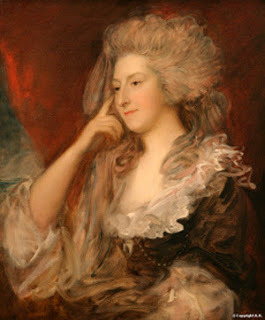 Mrs. Fitzherbert by Gainsborough, 1787Prince George had another wife, Maria Fitzherbert, though the union was not legal according to the requirements of the laws regarding royal marriages. Maria put up with a lot of misbehavior from George too. He left her not only for a legal wife, however temporarily, but also had numerous mistresses while he was associating with her. Like Caroline, Maria loved children; both women adopted other children on whom they poured their maternal love. One hopes that all three of these women – Maria, Caroline and Charlotte – managed some degree of happiness in their lives as they were consistently disappointed by the whims and caprices of George, Prince of Wales.
Mrs. Fitzherbert by Gainsborough, 1787Prince George had another wife, Maria Fitzherbert, though the union was not legal according to the requirements of the laws regarding royal marriages. Maria put up with a lot of misbehavior from George too. He left her not only for a legal wife, however temporarily, but also had numerous mistresses while he was associating with her. Like Caroline, Maria loved children; both women adopted other children on whom they poured their maternal love. One hopes that all three of these women – Maria, Caroline and Charlotte – managed some degree of happiness in their lives as they were consistently disappointed by the whims and caprices of George, Prince of Wales.
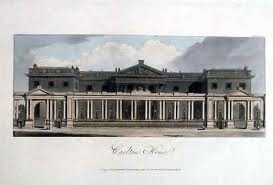 Prince George resided at Carlton House in London, a building he had turned into a palace filled with magnificent art works and sumptuous furnishings. Typical of his over-indulgence in all matters, as King, George IV had Carlton House demolished in 1825 for a new plan to enhance the new Regent Street. Meanwhile, he turned his Marine Pavilion in Brighton, from the tasteful building completed by Henry Holland in 1787, below, into a fantastical building in which the interior is Chinese style while the exterior is Indian-Mughal, whatever that is. Rev. Sydney Smith remarked upon seeing the Pavilion, "It looks like St. Paul's Cathedral came down and pupped."
Prince George resided at Carlton House in London, a building he had turned into a palace filled with magnificent art works and sumptuous furnishings. Typical of his over-indulgence in all matters, as King, George IV had Carlton House demolished in 1825 for a new plan to enhance the new Regent Street. Meanwhile, he turned his Marine Pavilion in Brighton, from the tasteful building completed by Henry Holland in 1787, below, into a fantastical building in which the interior is Chinese style while the exterior is Indian-Mughal, whatever that is. Rev. Sydney Smith remarked upon seeing the Pavilion, "It looks like St. Paul's Cathedral came down and pupped."
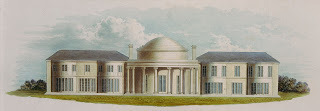 The Marine Pavilion, Brighton
The Marine Pavilion, Brighton
Henry Holland, Architect, 1787
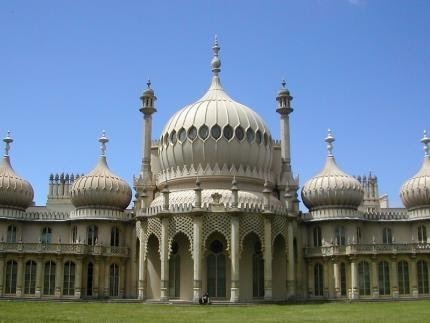 Brighton Pavilion, as remodeled by John Nash, after 1811England at the beginning of 1811 had been at war with France on and off for decades. British armies were fighting in the Peninsular Wars in Portugal and Spain. Shifting alliances among the continental European powers kept Britain's diplomats busy negotiating and re-negotiating treaties and mutual support pacts. The Prince Regent left the hard jobs to his ministers while he concentrated on his social life, his collections, his designs for army uniforms, and other even more trivial matters. We will dip further into some of these in future posts.
Brighton Pavilion, as remodeled by John Nash, after 1811England at the beginning of 1811 had been at war with France on and off for decades. British armies were fighting in the Peninsular Wars in Portugal and Spain. Shifting alliances among the continental European powers kept Britain's diplomats busy negotiating and re-negotiating treaties and mutual support pacts. The Prince Regent left the hard jobs to his ministers while he concentrated on his social life, his collections, his designs for army uniforms, and other even more trivial matters. We will dip further into some of these in future posts.
But George never was very popular. Sometimes the press was full of praise, but between the essayists, satirists and artists of caricatures, the Regent took his full share of criticism.
Here is a fragment of the praiseful poem published by the Morning Post newspaper in honor of the new Prince Regent:
Adonis! In thy shape and face,
A liberal heart and Princely grace
In thee are seen combined …
But Leigh Hunt and his brother John, editor of a literary magazine called the Examiner, published a different view:
"… An Adonis of 50 … a violator of his word, a libertine over head and ears in debt and disgrace, a despiser of domestic ties, the companion of gamblers and demi-reps, a man without a single claim to the gratitude of his country or the respect of posterity …"
Though many hailed them as heroes for their position, the Hunts were sued for and convicted of libel and served time in jail. Among the visitors to Leigh Hunt in prison were the poet Lord Byron, Lord Brougham, and essayist Charles Lamb.
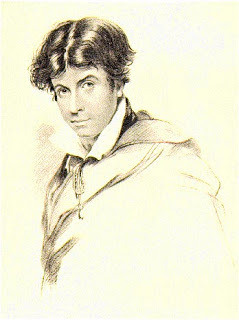 Leigh Hunt, essayist and critic, 1784-1859
Leigh Hunt, essayist and critic, 1784-1859
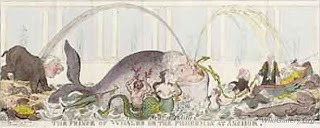
"The Prince of Whales, or The Fisherman at Anchor:
George Cruikshank, 1812
We will look at the Prince, or Prinny as many called him, and his reign many times in the upcoming months. It was a time of excess in many ways, and he certainly led the pack. We will see many more caricatures -- they were in their glory in those days -- and we will look at the real achievements of the Prince, particularly in assembling his collections of art and decorative arts.
At his Pavilion in Brighton, a new exhibition is about to open: Dress for Excess, Fashion in Regency England. suitable title, don't you agree? It will include the magnificent Coronation Robe worn by the Prince as he became George IV in 1921. Below, the King's portrait by Sir Thomas Lawrence (who else?).
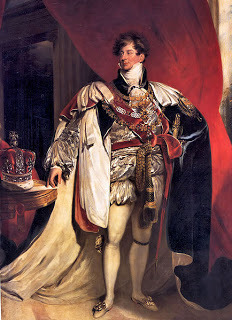


By February 5, 1811, both houses of Parliament had passed the Regency Act, making George, Prince of Wales, the Regent for his incapacitated father, George III, who was under doctors' care at Windsor Castle. The Prince took the royal oath on February 6, 1811.
He was 48 years old. He had a legal wife, Princess Caroline, whom he despised, and from whom he had been estranged since shortly after the wedding. Their daughter, Princess Charlotte of Wales, was 15 years old, and suffered from the great inconsistencies in her father's attention and attitude. She was most often ignored by him, but occasionally she was flaunted before the public, which adored her and loathed him.
 Princess Charlotte by Richard Woodman,
Princess Charlotte by Richard Woodman,1816, NPGCharlotte was a lively girl who had limited contact with both her mother and father. She was often with her aunts, the Princesses, and her grandmother, Queen Charlotte, and only rarely with girls of her own age. From time to time, the Prince spent time with her, but he complained that her looks reminded him, painfully, of his wife. Little wonder she had the German/Hanoverian stamp, since her George and Caroline were first cousins, both grandchildren of Frederick, Prince of Wales (1707-1751), the son of George II.Princess Charlotte led a lonely life, though surrounded at all times by attendants and court-appointed companions.
 Caroline, Princess of Wales
Caroline, Princess of Wales by Sir Thomas Lawrence, 1798, VandACaroline, by 1811, had set up a separate establishment where she entertained and socialized. Some of her behavior was reported to be scandalous, and her access to her daughter was often restricted. Caroline enjoyed -- and often flaunted -- her personal popularity with the people. She resented her position as a cast-aside wife with little or no access to court and none of the honors due her. Little wonder that there were constant rumors circulating in London society.
 Mrs. Fitzherbert by Gainsborough, 1787Prince George had another wife, Maria Fitzherbert, though the union was not legal according to the requirements of the laws regarding royal marriages. Maria put up with a lot of misbehavior from George too. He left her not only for a legal wife, however temporarily, but also had numerous mistresses while he was associating with her. Like Caroline, Maria loved children; both women adopted other children on whom they poured their maternal love. One hopes that all three of these women – Maria, Caroline and Charlotte – managed some degree of happiness in their lives as they were consistently disappointed by the whims and caprices of George, Prince of Wales.
Mrs. Fitzherbert by Gainsborough, 1787Prince George had another wife, Maria Fitzherbert, though the union was not legal according to the requirements of the laws regarding royal marriages. Maria put up with a lot of misbehavior from George too. He left her not only for a legal wife, however temporarily, but also had numerous mistresses while he was associating with her. Like Caroline, Maria loved children; both women adopted other children on whom they poured their maternal love. One hopes that all three of these women – Maria, Caroline and Charlotte – managed some degree of happiness in their lives as they were consistently disappointed by the whims and caprices of George, Prince of Wales. Prince George resided at Carlton House in London, a building he had turned into a palace filled with magnificent art works and sumptuous furnishings. Typical of his over-indulgence in all matters, as King, George IV had Carlton House demolished in 1825 for a new plan to enhance the new Regent Street. Meanwhile, he turned his Marine Pavilion in Brighton, from the tasteful building completed by Henry Holland in 1787, below, into a fantastical building in which the interior is Chinese style while the exterior is Indian-Mughal, whatever that is. Rev. Sydney Smith remarked upon seeing the Pavilion, "It looks like St. Paul's Cathedral came down and pupped."
Prince George resided at Carlton House in London, a building he had turned into a palace filled with magnificent art works and sumptuous furnishings. Typical of his over-indulgence in all matters, as King, George IV had Carlton House demolished in 1825 for a new plan to enhance the new Regent Street. Meanwhile, he turned his Marine Pavilion in Brighton, from the tasteful building completed by Henry Holland in 1787, below, into a fantastical building in which the interior is Chinese style while the exterior is Indian-Mughal, whatever that is. Rev. Sydney Smith remarked upon seeing the Pavilion, "It looks like St. Paul's Cathedral came down and pupped." The Marine Pavilion, Brighton
The Marine Pavilion, Brighton Henry Holland, Architect, 1787
 Brighton Pavilion, as remodeled by John Nash, after 1811England at the beginning of 1811 had been at war with France on and off for decades. British armies were fighting in the Peninsular Wars in Portugal and Spain. Shifting alliances among the continental European powers kept Britain's diplomats busy negotiating and re-negotiating treaties and mutual support pacts. The Prince Regent left the hard jobs to his ministers while he concentrated on his social life, his collections, his designs for army uniforms, and other even more trivial matters. We will dip further into some of these in future posts.
Brighton Pavilion, as remodeled by John Nash, after 1811England at the beginning of 1811 had been at war with France on and off for decades. British armies were fighting in the Peninsular Wars in Portugal and Spain. Shifting alliances among the continental European powers kept Britain's diplomats busy negotiating and re-negotiating treaties and mutual support pacts. The Prince Regent left the hard jobs to his ministers while he concentrated on his social life, his collections, his designs for army uniforms, and other even more trivial matters. We will dip further into some of these in future posts. But George never was very popular. Sometimes the press was full of praise, but between the essayists, satirists and artists of caricatures, the Regent took his full share of criticism.
Here is a fragment of the praiseful poem published by the Morning Post newspaper in honor of the new Prince Regent:
Adonis! In thy shape and face,
A liberal heart and Princely grace
In thee are seen combined …
But Leigh Hunt and his brother John, editor of a literary magazine called the Examiner, published a different view:
"… An Adonis of 50 … a violator of his word, a libertine over head and ears in debt and disgrace, a despiser of domestic ties, the companion of gamblers and demi-reps, a man without a single claim to the gratitude of his country or the respect of posterity …"
Though many hailed them as heroes for their position, the Hunts were sued for and convicted of libel and served time in jail. Among the visitors to Leigh Hunt in prison were the poet Lord Byron, Lord Brougham, and essayist Charles Lamb.
 Leigh Hunt, essayist and critic, 1784-1859
Leigh Hunt, essayist and critic, 1784-1859
"The Prince of Whales, or The Fisherman at Anchor:
George Cruikshank, 1812
We will look at the Prince, or Prinny as many called him, and his reign many times in the upcoming months. It was a time of excess in many ways, and he certainly led the pack. We will see many more caricatures -- they were in their glory in those days -- and we will look at the real achievements of the Prince, particularly in assembling his collections of art and decorative arts.
At his Pavilion in Brighton, a new exhibition is about to open: Dress for Excess, Fashion in Regency England. suitable title, don't you agree? It will include the magnificent Coronation Robe worn by the Prince as he became George IV in 1921. Below, the King's portrait by Sir Thomas Lawrence (who else?).

Published on February 05, 2011 02:00
February 4, 2011
On The Shelf - Discovering New Authors - Part Two
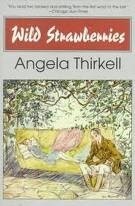 Victoria, here, continuing the Gentle Reads section of our book recommendations. Angela Thirkell is a delight. But then, you already knew I thought so, didn't you? As a card-carrying member of The Angela Thirkell Society, I really love her books. The Barsetshire novels are wonderful -- witty and liberally dosed with snippets of biting social satire - please try them! But she also wrote some other works -- one I particularly enjoyed was A Tribute to Harriette -- The Surprising Career of Harriette Wilson published in 1936 in England as The Fortunes of Harriette. This, perhaps not totally gentle and thus ineligible for this particular blog, is the story of the famous Regency Courtesan. But back to Thirkell's Barsetshire novels, here's the blurb for Wild Strawberries taken from the Thirkell Society website, where you can also find synopsis of all the books in the series: "Action in Thirkells third Barsetshire novel centers around the extended family of the Leslies of Rushwater House. Lady Emily reigns behind a self-generated thicket of confusion and turmoil. There is no event so settled that Lady Emily cannot throw it into chaos at the last moment. Mr. Leslie has been known to take off on a cruise to the "Northern capitals of Europe" when it all becomes too much for him. Their daughter Agnes, a matriarch-in-waiting, has already produced three children despite a husband who seems to be perennially abroad on some unspecified activity. The French tenants and Mr. Holt, the consummate social leech, are skillfully and humorously dealt with as is the household struggle for control between Housekeeper and Nannie. Even the small children, James, Emmy, and Clarissa are fully defined and serve to reveal the character of the adults as they interact with them. As usual we have the " young man with crush on older woman", one match completed, and others set up for the future."
Victoria, here, continuing the Gentle Reads section of our book recommendations. Angela Thirkell is a delight. But then, you already knew I thought so, didn't you? As a card-carrying member of The Angela Thirkell Society, I really love her books. The Barsetshire novels are wonderful -- witty and liberally dosed with snippets of biting social satire - please try them! But she also wrote some other works -- one I particularly enjoyed was A Tribute to Harriette -- The Surprising Career of Harriette Wilson published in 1936 in England as The Fortunes of Harriette. This, perhaps not totally gentle and thus ineligible for this particular blog, is the story of the famous Regency Courtesan. But back to Thirkell's Barsetshire novels, here's the blurb for Wild Strawberries taken from the Thirkell Society website, where you can also find synopsis of all the books in the series: "Action in Thirkells third Barsetshire novel centers around the extended family of the Leslies of Rushwater House. Lady Emily reigns behind a self-generated thicket of confusion and turmoil. There is no event so settled that Lady Emily cannot throw it into chaos at the last moment. Mr. Leslie has been known to take off on a cruise to the "Northern capitals of Europe" when it all becomes too much for him. Their daughter Agnes, a matriarch-in-waiting, has already produced three children despite a husband who seems to be perennially abroad on some unspecified activity. The French tenants and Mr. Holt, the consummate social leech, are skillfully and humorously dealt with as is the household struggle for control between Housekeeper and Nannie. Even the small children, James, Emmy, and Clarissa are fully defined and serve to reveal the character of the adults as they interact with them. As usual we have the " young man with crush on older woman", one match completed, and others set up for the future."I will add three more of my old faves for this gentle blog: Mazo de la Roche, Rosamund Pilcher, and Mary Stewart. I won't write here -- but soon -- about Georgette Heyer. I could add lots more -- both my mother and my grandmother had excellent noses for historical fiction: think Victoria Holt aka Jean Plaidy and several other pen names, whose real name was Eleanor Hibbert; Frances Parkinson Keyes; Kathleen Winsor; Catherine Cookson, Frank Yerby and many more. You can google these names for lists of their novels and more details.
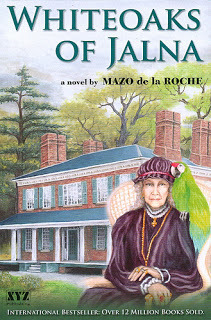 Mazo de la Roche (1879-1961), born in Canada, wrote a continuing family saga about the Whiteoak family at Jalna, an estate in Ontario, through many generations. Jalna, her third novel, published in 1927, brought her fame, best-sellerdom, and fortune. The last of the series, Centenary at Jalna, came out in 1958. A film was made of Jalna in 1935 and the CBC presented a series on the books, sometimes known as the Whiteoak Chronicles, in 1958. Sadly, these books have not been reissued since the 1970's and are now long overdue for a revival.
Mazo de la Roche (1879-1961), born in Canada, wrote a continuing family saga about the Whiteoak family at Jalna, an estate in Ontario, through many generations. Jalna, her third novel, published in 1927, brought her fame, best-sellerdom, and fortune. The last of the series, Centenary at Jalna, came out in 1958. A film was made of Jalna in 1935 and the CBC presented a series on the books, sometimes known as the Whiteoak Chronicles, in 1958. Sadly, these books have not been reissued since the 1970's and are now long overdue for a revival.
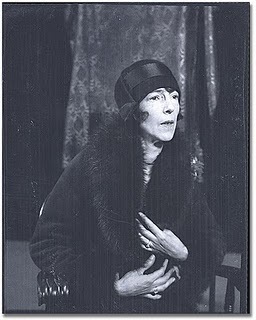 Mazo de la Roche
Mazo de la Roche The fictional Whiteoaks family originated in England, made a fortune in India, and came to Canada to establish the North American version of a country estate. The series was not written in chronological order, but can be read that way for ease of keeping the various branches of the Whiteoaks from tangling. My grandmother treasured these books and they were among my earliest grown-up reads, carefully and secretly eased from her bookshelves and spirited away to be read outside of the view of any adult. Not that the writing was particularly shocking, but some of the themes -- affairs, homosexuality, incest, e.g. -- were not for childish eyes (at least back then!).
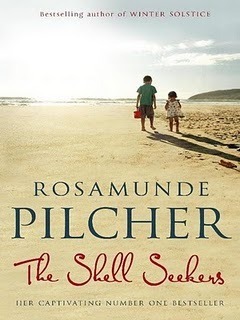 Rosamund Pilcher's most famous book is probably The Shell Seekers published in 1988. Born in 1924 in Cornwall, she had written many romances as Jane Fraser for Millls and Boon. She served in the British navy in WWII before marrying and turning to fiction. Many of her stories have been made into films and tv series, bringing enojyment to viewers all over the world; according to various websites, she is particularly popular in Germany. The Shell Seekers was a worldwide bestseller, the reminiscences of Penelope Keeling, daughter of a famous artist. In the movie version (1989), she was played by Angela Lansbury and in the tv version (2006) by Vanessa Redgrave. That should give you some idea of the quality of the story and the character. I think I will go to the library next week and take it out again. Definitely worth a re-reading.
Rosamund Pilcher's most famous book is probably The Shell Seekers published in 1988. Born in 1924 in Cornwall, she had written many romances as Jane Fraser for Millls and Boon. She served in the British navy in WWII before marrying and turning to fiction. Many of her stories have been made into films and tv series, bringing enojyment to viewers all over the world; according to various websites, she is particularly popular in Germany. The Shell Seekers was a worldwide bestseller, the reminiscences of Penelope Keeling, daughter of a famous artist. In the movie version (1989), she was played by Angela Lansbury and in the tv version (2006) by Vanessa Redgrave. That should give you some idea of the quality of the story and the character. I think I will go to the library next week and take it out again. Definitely worth a re-reading.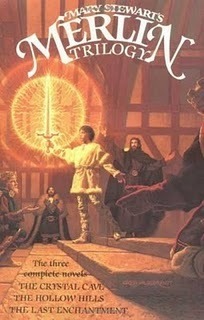
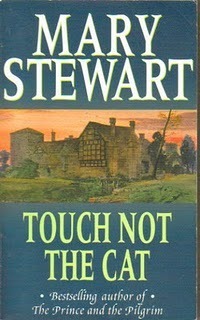 Everything you want to know about Mary Stewart and her wonderful novels can be found here. She has written many, including the Merlin books, a wonderful re-telling of the King Arthur saga in five volumes. She is also well known for her romantic suspense novels, some once known as neo-gothic or woman-in-jeopardy. Lots of suspense and a happy ending, the perfect gentle result even if the action can be bone-chilling from time to time. Born in 1916, Mary Stewart was awarded an honorary doctorate in 2009 from her alma mater Durham University, where she also taught before her marriage to Sir Frederick Stewart in 1945. Perhaps the most gentle of her books is Rose Cottage, 1997. But I think my favorite, aside from the Merlin books, is Touch Not the Cat, from 1976. Here's the marketing blurb: "Bryony Ashley knows that her family's grand estate is both hell and paradise -- once elegant and beautiful, yet mired in debt and shrouded in shadow. Devastated by her father's sudden strange death abroad, she is nonetheless relieved to learn the responsibility of running Ashley Court has fallen to a cousin. Still, her father's final, dire warning about a terrible family curse haunts her days and her dreams."
Everything you want to know about Mary Stewart and her wonderful novels can be found here. She has written many, including the Merlin books, a wonderful re-telling of the King Arthur saga in five volumes. She is also well known for her romantic suspense novels, some once known as neo-gothic or woman-in-jeopardy. Lots of suspense and a happy ending, the perfect gentle result even if the action can be bone-chilling from time to time. Born in 1916, Mary Stewart was awarded an honorary doctorate in 2009 from her alma mater Durham University, where she also taught before her marriage to Sir Frederick Stewart in 1945. Perhaps the most gentle of her books is Rose Cottage, 1997. But I think my favorite, aside from the Merlin books, is Touch Not the Cat, from 1976. Here's the marketing blurb: "Bryony Ashley knows that her family's grand estate is both hell and paradise -- once elegant and beautiful, yet mired in debt and shrouded in shadow. Devastated by her father's sudden strange death abroad, she is nonetheless relieved to learn the responsibility of running Ashley Court has fallen to a cousin. Still, her father's final, dire warning about a terrible family curse haunts her days and her dreams."Part Three Coming Soon!
Published on February 04, 2011 01:21
February 3, 2011
Regency Reflections: Leading up to the Regency of Prince George, 1811
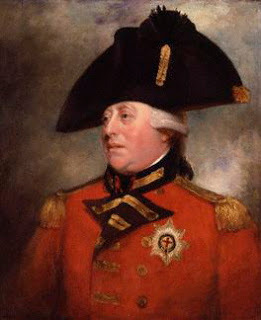 George III, c.1809; studio of Sir William Beechey, NPGAfter the first regency crisis in 1788-89, George III had occasional relapses of illness and mental incapacity. However, each time he would gradually recover, and he retained the powers of his office for more than two decades.
George III, c.1809; studio of Sir William Beechey, NPGAfter the first regency crisis in 1788-89, George III had occasional relapses of illness and mental incapacity. However, each time he would gradually recover, and he retained the powers of his office for more than two decades.George, Prince of Wales, bided his time, indulging in his characteristic excesses. He was not esteemed by the common people. He complained that he was not given an important post in the Army, like his brother Frederick, Duke of York, or in the Navy like his brother William, Duke of Clarence. This is how he was caricatured by James Gillray (1757-1815) in 1792 as A Voluptuary Under the Horrors of Digestion.
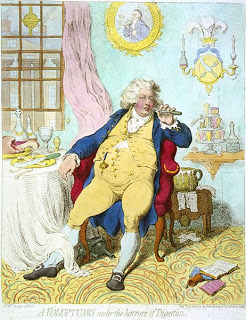 James Gillray, 1792
James Gillray, 1792
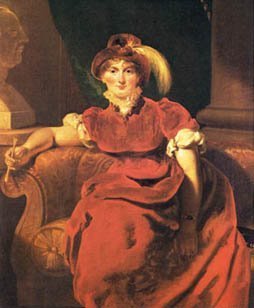 Caroline, Princess of Wales by LawrenceAcceding to his father's and Parliament's wishes, and to pay his debts, in 1795 he married his cousin Caroline of Brunswick, a marriage which lasted only a few days or weeks before they were effectively estranged forever. Nevertheless, a child was born nine months after the ceremonies, Princess Charlotte. At last there was a legitimate grandchild who could inherit the throne.
Caroline, Princess of Wales by LawrenceAcceding to his father's and Parliament's wishes, and to pay his debts, in 1795 he married his cousin Caroline of Brunswick, a marriage which lasted only a few days or weeks before they were effectively estranged forever. Nevertheless, a child was born nine months after the ceremonies, Princess Charlotte. At last there was a legitimate grandchild who could inherit the throne.Marriage did nothing to improve Prince George; in fact it may have increased his reckless behavior.
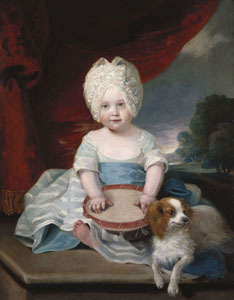 Princess Amelia, Hoppner, 1785The leaders of both political parties died in 1806, William Pitt, the Tory Prime Minister in January and Whig leader Charles James Fox in September, leaving a new cast of characters to assess the need for a regency.
Princess Amelia, Hoppner, 1785The leaders of both political parties died in 1806, William Pitt, the Tory Prime Minister in January and Whig leader Charles James Fox in September, leaving a new cast of characters to assess the need for a regency.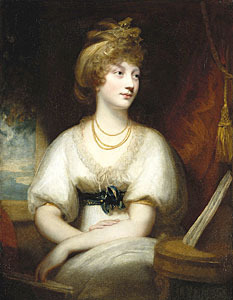 Princess Amelia, 1783-1810, by William Beechey The British people had grown fond of their old king and his jubilee, celebrating 50 years on the throne, was widely acclaimed in 1809. The next year, King George III's madness recurred. He was much distressed by the fatal illness of his youngest daughter, Princess Amelia. Though she chafed at the strictness of her parents and her virtual imprisonment at Windsor, she loved her father. Anticipating her death, she had a special jewel set for him including a lock of her hair. The very sight of it caused him tears.
Princess Amelia, 1783-1810, by William Beechey The British people had grown fond of their old king and his jubilee, celebrating 50 years on the throne, was widely acclaimed in 1809. The next year, King George III's madness recurred. He was much distressed by the fatal illness of his youngest daughter, Princess Amelia. Though she chafed at the strictness of her parents and her virtual imprisonment at Windsor, she loved her father. Anticipating her death, she had a special jewel set for him including a lock of her hair. The very sight of it caused him tears.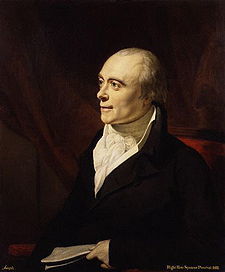 The Prime Minister in 1810-11 was Spencer Perceval (1762-1812), who presided over a fractious set of ministers. Perceval, who called himself "not a Tory but a follower of Pitt", did not like the Prince. The feeling was mutual. Perceval had taken the side of Caroline, Princess of Wales, in her disputes with her husband, and George was not a forgiving man.
The Prime Minister in 1810-11 was Spencer Perceval (1762-1812), who presided over a fractious set of ministers. Perceval, who called himself "not a Tory but a follower of Pitt", did not like the Prince. The feeling was mutual. Perceval had taken the side of Caroline, Princess of Wales, in her disputes with her husband, and George was not a forgiving man. But after much discussion and examination of the King by doctors and politicians alike, Perceval told the Prince that the Parliament would discuss a bill to establish a regency. George was to be ruler in the name of his father. The prince was not pleased with the restrictions placed on his actions by the bill, which was very similar to the one passed by Commons and almost passed by the House of Lords in 1789. These restrictions had mainly to do with the creations of peerages and other offices, awards and pensions. The Queen would be responsible for the care of the King.
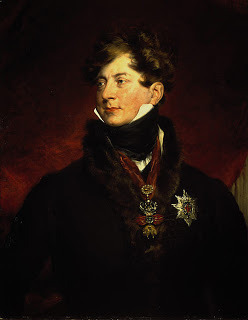 For some of the members of both Commons and Lords, the bill gave too much power to the Prince. But despite the bill's shortcomings, it passed in early February, 1811, and the Regency was established. The Prince took the Royal Oath on February 6.
For some of the members of both Commons and Lords, the bill gave too much power to the Prince. But despite the bill's shortcomings, it passed in early February, 1811, and the Regency was established. The Prince took the Royal Oath on February 6.To the surprise of almost everyone, the Prince Regent did not choose new ministers from his close friends, the Whigs. The Parliament had many issues on its agenda, such as continuation of the Peninsular War, the problems of Ireland, and banking concerns.
Meanwhile, the Prince Regent continued his spendthrift ways. He prided himself on his connoisseurship; he built, remodeled, bought, collected and wasted incredible amounts of public money. However, for the remainder of the regency and his ten years as George IV, his tastes and his extravagances gave Britain a lasting legacy in the royal collections and palaces. Whether it had anything to do with his influence or not, there was a flowering of literary talent on his watch. Byron, Keats, Shelley, Austen, Scott – an endless list. And the painters Constable, Turner, Lawrence and many others were at the top of their games. Architecture, the decorative arts, and garden design developed brilliantly.
We will investigate many of these topics further over the year.
[image error]
Published on February 03, 2011 02:00
Kristine Hughes's Blog
- Kristine Hughes's profile
- 6 followers
Kristine Hughes isn't a Goodreads Author
(yet),
but they
do have a blog,
so here are some recent posts imported from
their feed.



